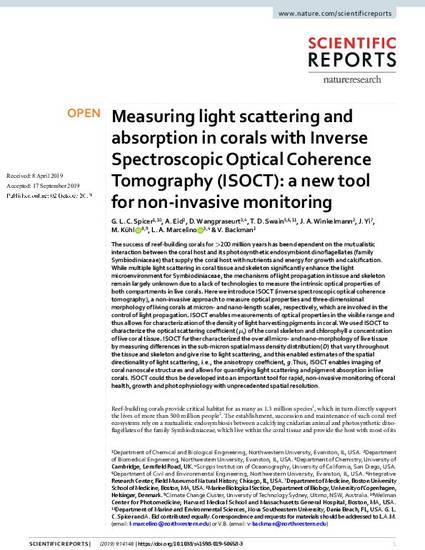
The success of reef-building corals for >200 million years has been dependent on the mutualistic interaction between the coral host and its photosynthetic endosymbiont dinoflagellates (family Symbiodiniaceae) that supply the coral host with nutrients and energy for growth and calcification. While multiple light scattering in coral tissue and skeleton significantly enhance the light microenvironment for Symbiodiniaceae, the mechanisms of light propagation in tissue and skeleton remain largely unknown due to a lack of technologies to measure the intrinsic optical properties of both compartments in live corals. Here we introduce ISOCT (inverse spectroscopic optical coherence tomography), a non-invasive approach to measure optical properties and three-dimensional morphology of living corals at micron- and nano-length scales, respectively, which are involved in the control of light propagation. ISOCT enables measurements of optical properties in the visible range and thus allows for characterization of the density of light harvesting pigments in coral. We used ISOCT to characterize the optical scattering coefficient (μs) of the coral skeleton and chlorophyll a concentration of live coral tissue. ISOCT further characterized the overall micro- and nano-morphology of live tissue by measuring differences in the sub-micron spatial mass density distribution (D) that vary throughout the tissue and skeleton and give rise to light scattering, and this enabled estimates of the spatial directionality of light scattering, i.e., the anisotropy coefficient, g. Thus, ISOCT enables imaging of coral nanoscale structures and allows for quantifying light scattering and pigment absorption in live corals. ISOCT could thus be developed into an important tool for rapid, non-invasive monitoring of coral health, growth and photophysiology with unprecedented spatial resolution.
Available at: http://works.bepress.com/timothy-swain/34/

Open Access This article is licensed under a Creative Commons Attribution 4.0 International License, which permits use, sharing, adaptation, distribution and reproduction in any medium or format, as long as you give appropriate credit to the original author(s) and the source, provide a link to the Creative Commons license, and indicate if changes were made. The images or other third party material in this article are included in the article’s Creative Commons license, unless indicated otherwise in a credit line to the material. If material is not included in the article’s Creative Commons license and your intended use is not permitted by statutory regulation or exceeds the permitted use, you will need to obtain permission directly from the copyright holder. To view a copy of this license, visit http://creativecommons.org/licenses/by/4.0/.